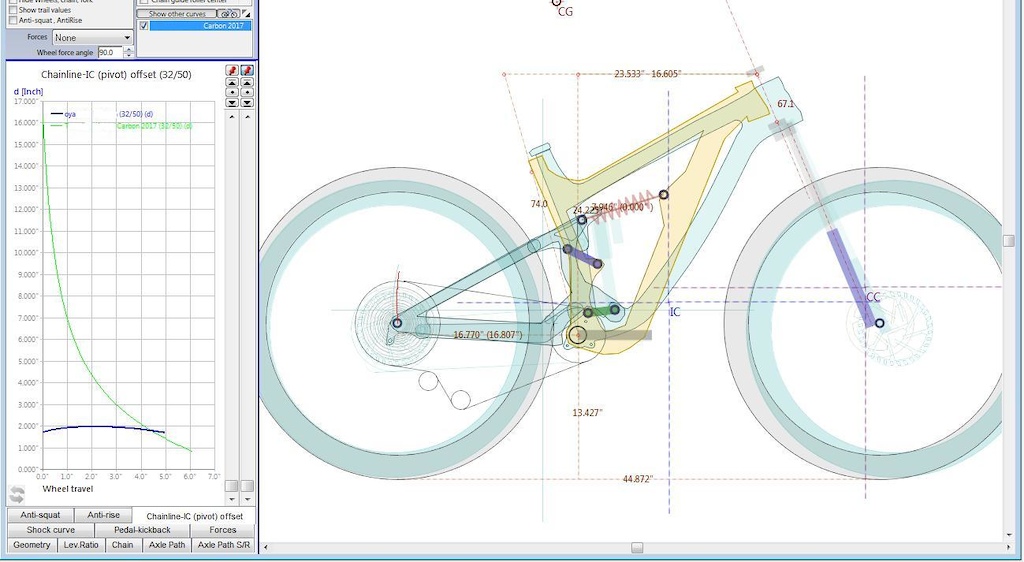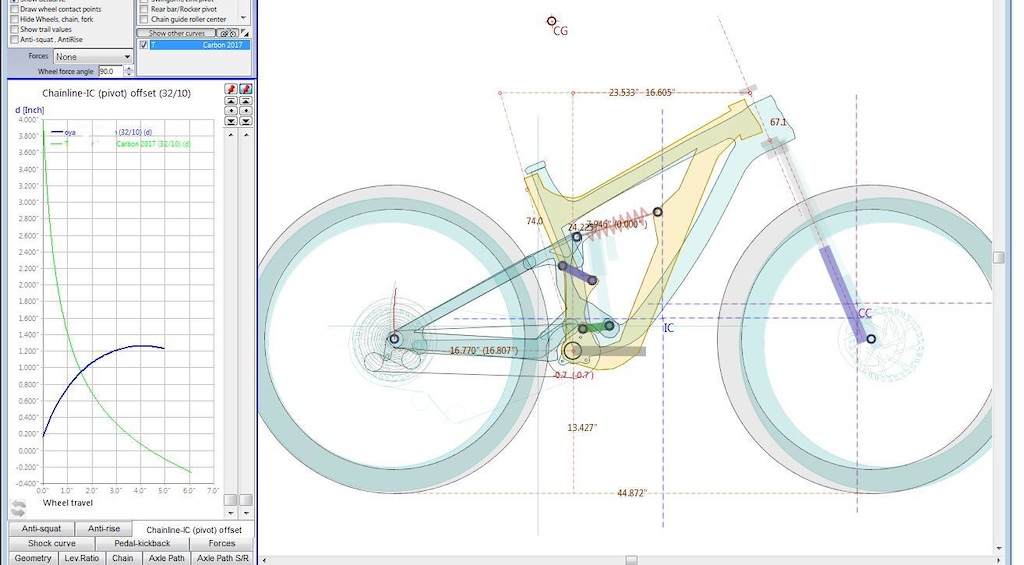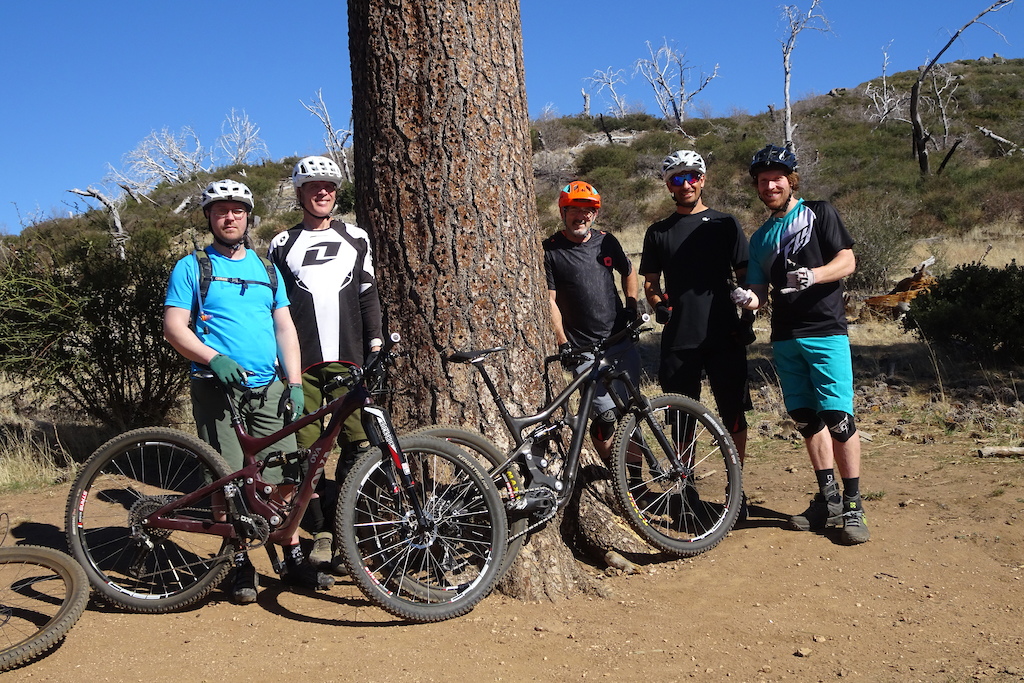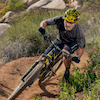First Ride: Promising New Suspension Design From an Unlikely Source

Damon Madsen worked out a different take on the short-link, four-bar rear suspension, and then built a carbon chassis to prove the concept.
Think of a new suspension design, and you’ll probably recall that it was released with much fanfare by an established brand that needed to differentiate its product to a greater degree, perhaps, than the innovation could possibly enhance the performance of said product. There is a point where weeding out the tech from the tech-speak becomes a chore – so I’ll excuse you in advance for your skepticism before I introduce Damon Madsen and the very promising rear suspension that he has developed.
Damon Madsen’s Rear Suspension
Damon Madsen is a true story. He lives in a basement studio in a farming community near Jerome, Idaho. He has a day job welding stainless steel tank trailers. He comes from a hard-working family of precision machinists, and he was born to make stuff. It was inevitable, then, that Madsen’s natural gift would collide with his passion for mountain bikes.
Madsen skipped steel hardtail 101. Using his skills as a sculptor and some surplus carbon from Boeing Aerospace, he launched himself into building carbon fiber frames. Five years later, I got an email from Madsen, asking me to have a look at a dual-suspension bike and a patent application for its kinematics. There was also an offer: “Would you like to ride one?” It looked good. A while later, Madsen packed two of his creations into a beater Buick LeSabre and drove non-stop, 2,000 miles south to join me for a test ride.
Madsen skipped steel hardtail 101. Using his skills as a sculptor and some surplus carbon from Boeing Aerospace, he launched himself into building carbon fiber frames. Five years later, I got an email from Madsen, asking me to have a look at a dual-suspension bike and a patent application for its kinematics. There was also an offer: “Would you like to ride one?” It looked good. A while later, Madsen packed two of his creations into a beater Buick LeSabre and drove non-stop, 2,000 miles south to join me for a test ride.
What’s Going on Here?
Damon’s suspension design is a take on the very popular short, dual-link configuration. The upper link swings in a conventional manner, but the lower link is positioned ahead of the seat tube, where chain forces put it in tension. (Most lower links are in compression while pedaling.) As with all four-bar suspensions, the linkage geometry creates a virtual pivot (instant center), where the swingarm hinges. As the suspension compresses, that instant center migrates, and where it migrates to affects important suspension kinematics. Good ones, like anti-squat and shock leverage rates, and bad ones, like pedal kick-back and adverse braking torque.

Madsen's dual-link configuration reverses the orientation of the lower control link from the rear to the front of the bottom bracket axle.
Damon wanted his suspension to pedal firmly and consistently regardless of where it happened to be in its travel range and he wanted it to move easily in response to impacts. His solution was to configure the links so that the pivot location (instant center) begins well ahead of the bottom bracket and lined up with the chain. As the suspension moves through its travel, the pivot location migrates rearward, but remains in proximity of the chain. That action, he claims, provides a consistent measure of anti-squat forces at any point in the suspension's travel.

One of Madsen's patent drawings: The numbers are referenced in the patent description below. Most of the action relates to the migration of the instant center (10, 11 and 12) and how it parallels the chain line (21).
Excerpts From the Patent Application
[0009] When an imaginary line is drawn through rear pivot point 6 of upper link 3 and front pivot point 5 of upper link and an imaginary line is drawn through rear pivot point 7 of lower link 4 and front pivot point 8 of lower link an intersecting point of these two imaginary lines is formed and denotes the IC of Figure 1 when the shock is in a non-compressed state. This intersecting point is called the instant center, IC for short.
As the suspension system compresses the front pivot point 8 of the lower link 4 moves upward and the rear pivot point 6 of the upper link moves forward. If imaginary lines are drawn through the pivot points 6 and 5 of the upper link 3 and pivot points 7 and 8 of lower link 4 throughout the range of movement as the suspension compresses the IC can be plotted forming and IC path 10 with an IC start point 11 and an IC end point 12.
[0010] The IC path begins in front of the front chainring 20 slightly below being even with the top of the circumference of the chainring 20 and moves (or migrates) rearward and slightly upward as the suspension compresses. This IC path movement maintains the IC above the chain [5] torque line 21 throughout the range of suspension compression in the lower gear combinations and for the most part keeps the IC above the chain torque line 21 in the higher gear combinations. This produces an anti-squat curve that increases in value as the suspension compresses thus aiding and producing pedal efficiency while the connection between rear triangle 2 and the lower link at pivot point 8 being in front of the front chainring 20 produces sensitivity and responsiveness to rough terrain.
Primarily, the patent language is describing that the pivot point (IC) of the swingarm maintains about the same height above the chain line as the suspension compresses in both the low gears (32 x 50 on the left), and through most of the suspension travel in the high gears (32 x 10 on the right). This provides a consistent pedaling platform (anti-squat).
[0011] Figure 6 and Figure 7 illustrate the distance of the IC above an imaginary line throughout the travel range for the depicted gear for the embodiment of a rear suspension shown in Figure 1. Figure 6 illustrates the distance of the IC from the chainline through the range of travel in a 32/50 gearing. The distance on the y-axis illustrates the distance above the upper chainline as the embodiment of the rear suspension travels through its range of travel as depicted on the x-axis of Figure 6. Figure 7 illustrates the same concept as Figure 6 but for showing the migration of the IC through the range of travel of the rear suspension shown in a 32/10 gearing.
Here's How it Looks in Action:
Forward Facing Link
Madsen says that one of the downsides to rear suspensions with high anti-squat numbers (his hovers around 100%) is that the price of that firm pedaling action is that the rear suspension is initially reluctant to move. His solution was to reconfigure the position of the lower link from the rear to the front of the bottom bracket axle. The switch, he claims, provides a mechanical advantage for the suspension when it sees an impact. The result is a more supple ride, even at high anti-squat values.
Suspensions with high anti-squat values usually suffer from pedal feedback. Madsen admits there is no escaping the fact, but he says that his kinematics minimize chain growth to acceptable levels. He also was pleased to discover that his linkage does not adversely affect rear braking. When asked how his kinematics achieved that, Madsen explained that some of the braking performance was simply a result of moving the IC of the swingarm forward of the bottom bracket, while some was due to the geometry of the four-bar linkage.
Madsen says that one of the downsides to rear suspensions with high anti-squat numbers (his hovers around 100%) is that the price of that firm pedaling action is that the rear suspension is initially reluctant to move. His solution was to reconfigure the position of the lower link from the rear to the front of the bottom bracket axle. The switch, he claims, provides a mechanical advantage for the suspension when it sees an impact. The result is a more supple ride, even at high anti-squat values.
Suspensions with high anti-squat values usually suffer from pedal feedback. Madsen admits there is no escaping the fact, but he says that his kinematics minimize chain growth to acceptable levels. He also was pleased to discover that his linkage does not adversely affect rear braking. When asked how his kinematics achieved that, Madsen explained that some of the braking performance was simply a result of moving the IC of the swingarm forward of the bottom bracket, while some was due to the geometry of the four-bar linkage.
About the Bike
Madsen needed to devise a method to lay up a carbon frame that allowed him the freedom to reconfigure the geometry and suspension kinematics. Crafting a mold for each design change was out of the question. His compromise was to machine aluminum molds for his swingarm, which was a constant between models. Front sections are not molded. Madsen forms the head tube and bottom bracket areas from balsa wood, formed in hollow halves and then sculpted into shape. Lightweight Carbon tubes span the distances between the balsa mandrels. Pre-machined aluminum inserts are placed at the bottom bracket and pivot locations, after which all the bits are glued together in a frame fixture.
At this point, Madsen layers pre-preg carbon over the entire frame in much the same way as production molded front section is laid up. To cure the carbon front section, however, Madsen uses an external "vacuum bag" that squeezes down on the carbon while the frame is bring cured in an oven. "There is more sanding and finish work," says Madsen. "But, the end product is as strong as a molded frame and I have the flexibility to changes sizes or to make changes without spending thousands on a new mold." The balsa mandrels remain in place, but the technique produces frames at competitive trail bike weights.
My demo bike was Madsen's trail design, with 130-millimeters of rear-wheel travel and a 140-millimeter fork. He said the suspension rode on Enduro Max bearings and assured me that the geometry was up to date. The medium-size chassis rolls on 29-inch wheels, with a 74.5-degree seat angle, a 67-degree head angle, and a 23.5-inch top tube.
First Ride
With only one day to evaluate the suspension, I selected a 12-mile descent that is infamous for its variety of soil and features, which range from successive high-speed corners to technical rock gardens, with some punchy climbs mixed in. To establish the pedaling and efficiency of Madsen's design, I added some peripheral trails with fast-paced rolling climbs. On the bike time was a little over three hours - ample riding to get a well-rounded sample of the suspension's performance.
Madsen says he used a Cane Creek damper because he needed a shock that could be tuned in every aspect - primarily because his suspension needs minimal damping. He had the low-speed compression turned all the way out, high-speed compression only three clicks in, and rebound forces were similarly light. Fork and shock sag was about 25 percent. I fit the medium-sized frame quite well and, once underway, I only made minor adjustments.
The first thing I noticed was how stable the bike was at ride height. It was remarkably predictable in the turns, with a firm feel through the pedals to the tires, and no tendency to rock back on the rear suspension when pushing through the apex. Climbing was similar, with the rear of the bike compressing much less than I anticipated, which kept the seat up and my legs in an effective pedaling position.
I kept the Cane Creek's pedaling lever in the open mode throughout the test. There was never a moment when I felt the rear suspension mushing, yet anytime I looked down, the shock was moving freely. Watching that dichotomy in action provided the aha moment, when I realized that Madsen's discovery was truly special. Madsen told me I should expect the bike I was riding to feel a little on the firm side of plush, because it was intended to be more of a cross-country trail bike. That was true, but if you set up most bikes to feel that firm under power, they would ride proportionally rougher as speed or the amplitude of the terrain increased. Madsen's suspension provides a consistent level of pedaling firmness, regardless of what the suspension is up to.
Two very fast runs over large, uneven boulders pushed the suspension beyond its capabilities. It was clear that the high speed rebound damping was preventing the shock from extending, which made for some exciting moments. I got bucked off line, but the bike had enough handling in the bank to recover. No bike gets down that section easily - one of our group broke a wheel there. Madsen admitted that the Cane Creek shock's rebound was too slow for his system, but to get his suspension tune in the ballpark, its external adjustments made it the most practical (and affordable) tool. The next step is to find a suspension maker that will work with him to suss out a dedicated shock tune..
First Impressions:
Author Info:
Must Read This Week
How to Watch the 2024 Mountain Bike World Cup [Update: Staylive Offering Access in New Zealand, South Africa & More]
60325 views
60325 views
[UPDATED] Final Elite XC Results & Overall Standings from the Mairiporã XC World Cup 2024
41242 views
41242 views
Sign Up for the Pinkbike Newsletter - All the Biggest, Most Interesting Stories in your Inbox
PB Newsletter Signup








"Amazing, only one catch, the rear shock can only be inflated by the breath of a deep sea squid"
F**K IT, I QUIT
By moving the pivots forward, wouldn't you make the bike have more drastic sag changes when you are seated versus climbing?
Yeah, I agree.... can anyone tell me what bottle cage that is? It looks like a YT, but curious if someone else makes that right hand removal.
In addition the IC moves rewards during compression, i.e. the axle path becomes always worth ...
There is reason why mondraker (or Cesa Rojo), Giant, Banshee and others choose the opposite design.
Hope he can patent it all and then license it out
[url] www.instagram.com/p/BSfV-QAAf8K/?taken-by=hondabob1 [/url]
Actually, I think you mean Trek's Re:Aktiv or Marin's R3ACT
Is his intent to start his own company and make bikes or sell this solution to someone?
I can't imagine how many hours he has into this project if he did it all himself.
2) Lets hope so!
dirtragmag.com/exclusive-dirt-rag-test-rides-new-prototype-from-chris-currie-and-speedgoat-cycles
Not saying it is 100% the same, but the whole forward linkage thing has a patent on it already.... GIF and video look pretty much the same other than the shock orientation.
Like @RichardCunningham notes, liberating that lower link from compression can do some pretty amazing things when it comes to combining higher anti-squat with sensitivity. My design has been licensed, by the way. I've been riding pre-productions for months now. They are real damn good. Everybody will finally be able to see what I've been up to for the past 12 years this April at Sea Otter.
All I want for Christmas is my Canfield Jedi minus the upper pulley, minus half of the rearward axle motion (but FFS keep half of that rearward travel) minus 20-40mm travel, and minus several pounds.
Why nobody does this is a mystery to me. Is there some terrible disadvantage that I'm not seeing? Even Canfield dropped the rearward motion for their Enduro frame.
Trivially, chain tension can influence the behaviour of the rear suspension, of course. Why? Because, he/she who pedals determines how rough the terrain to be traversed will be and how fast the ride will go! But this tells us nothing about how the suspension works. The way some commenters are talking here following Richard Cunningham's lead treats chain tension as something that actively governs suspension linkage behaviour directly and implies that chain tension can and should be used to achieve some sort of stability of particular links without considering the linkage assembly that the singular link is just a part of. But, no stability comes by that route. It comes from the kinematics of the bike. Adding talk about tension on links that has somehow made its way from the chain and into the links (instead of the chain and the spinning wheel) is meaningless.
1) Suspension patents are a dime a dozen. If Ellsworth could get their joke of a patent thru, that should tell you they're not worth much. The USPTO reviewers really don't understand this stuff.
2) Look at the Currie and Berthold patents, the established players aren't tripping over themselves to fork over royalties for incremental improvement. Horst's patent served him well for a long time, but the early years were a different time.
3) The suspension suppleness and braking benefits posited here largely come down to a more forward IC. Locating the links in front of the BB/seat tube is not necessary to move the IC forward. Perhaps the benefit otherwise not achievable is the smaller migration of the IC from the chain line but folks aren't really complaining about current levels of anti squat and pedal kickback.
4) I can't think of any real benefit to having the links loaded in tension vs compression? But certainly there can be packaging benefits in the form of shorter CSs and bearings not in the debris path?
Incidentally the dude’s patent drawings are way better and more comprehensible than the ones put up by Shimano regarding electronic control of the bike. Shimano’s drawing didn’t even show a correctly working drivetrain. Sheez.
Well done sir
I do have a question though: Aren't the Kinematics, or at least the idea behind it, very similar to YETIS Switch?
The first version from a few years ago with the eccentric bearing set up near the BB did, to my understanding, the same thing like a forward control arm. Didn't it?
Most of these points, not all of which have kinematic implications, if they were ever debated in court, would probably result in Damon Madsen’s linkage being considered original enough for any patents on the linkage to be reaffirmed and consequently Madsen's linkage design could probably withstand a patent challenge. That won't stop anyone from making that challenge, of course. It wouldn't shock me if David Earle (who was awarded the patent on the technology that the Yeti Switch bikes were based on and the Alchemy bikes are still based on) decides to go to war with any mountain bike brand that starts to sell bikes using Madsen’s linkage.
Arguably, the Madsen linkage isn't an optimal variant of linkage type that he is experimenting with. If the upper linkage was located in a more rearward position and the link was shorter (and therefore rotationally faster) the anti-squat curve when driving small cogs (the obvious weak point of this linkage configuration) would probably be improved a lot. Those high anti-squat numbers when driving small cogs (32 tooth chainring/10 tooth cassette cog) are too high. Also, a linkage similar to Madsen's but with a more rearward and shorter upper link (with the same horizontal(ish) orientation around Sag as the current link) would naturally lead to a switch/rotational reversal in the lower link at some point in suspension travel! It goes without saying having a switch in the suspension linkage action definitely would result in a patent violation lawsuit. That is the world we live in.
Next guy who starts blabbing about Instant Center at my next mountain bike ride will get reassigned to a road ride.
And it's super awesome that it was developed by a dude who just loves riding and fiddling with stuff. Then again, the Horst link was developed by one guy and dual-link (VPP and derivative designs like DW link and Maestro) was developed by a couple of guys. Turns out that at least on a (relatively) simple device like a bicycle the best ideas can still come from one or two people tinkering in a garage.
Showing an antisquat curve without showing the resulting pedal kickback curve is simply misleading. Also where is the shock leverage curve ? Does anyone design a bike using IC offset curves? missing the big picture
and it isnt bad looking too. not that this matters much, but hey...!
hope he finds the right partners.
avalanche maybe for the first step in suspension shocks?
Bikes 2 & 3
this one looks better.
Like a Horste
Or a VPP
Only it turned 90%
is it a 150/140mm travel?
65/74 head n seat angle?
we need the numbers!!!!
The best innovations in any field often happen when an idea crosses over the line from one discipline to another.
For example: the uber of bike guiding. You going to St George Utah and want a guide who knows the trails? Local bike guides at your service. Set a schedule in advance and negotiate your price. App takes a cut. Suddenly it pays to ride.
You are welcome for the billion dollar idea. Run with it. Cut me in if you are feeling nice.
This is abuse of the patent system. Not as bad as software patents, but part of the reasOn half the patents are invalidated during litigations.
It is a well known problem, too bad you don’t know that.
Show me a bike using this linkage this way. There isn't one. Anyone who owns the patent and challenges him becomes a patent troll since they were sitting on a design waiting to sue anyone who worked out a way to use it. This guy clearly is working on getting the design out there. He is pushing a product. That is the opposite of a patent troll.
If there is preexisting art in the bike world that is in use then post it up and we can decide for ourselves if he is an opportunist. If it is on some F1 car that doesn't count. The forces in play are very different.